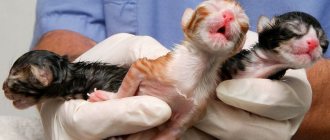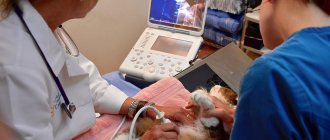Expecting kittens is always a very exciting stage for both the cat and the owner. Pregnancy in cats is different from that in women. In animals, childbirth takes place at the level of natural instincts and has a number of features. During this period, the cat needs to be provided with special care and know the finer points. In the article we will describe the stages of a cat’s pregnancy, the features of bearing kittens, and possible complications during this period. You will also learn how to organize care for a pregnant cat, tips for comfortable conditions during childbirth and after.
How to determine if a cat is pregnant
If the owners consciously engaged in breeding, then they will not have problems determining pregnancy in the early stages. What you should pay attention to:
- two weeks after mating, the cat’s appetite increases;
- gradual weight gain occurs;
- nipples become darker and increase in size;
- toxicosis is rare, but it also happens. The pet may begin to vomit and have diarrhea;
- more aggressive behavior.
Pregnancy is a crucial period in the life of an animal
For your information! If a cat and a pregnant cat live together, the male may begin to show additional signs of attention to his chosen one and constantly protect her.
First signs of pregnancy in Maine Coons
To diagnose pregnancy in a Maine Coon, you need to count 21 days from the last heat, during which a planned mating took place. The fact that mating gave a positive result is indicated by characteristic signs:
- The cat's nipples become noticeably pink.
- The Maine Coon does not go into another heat cycle. Most often, it occurs twice a year and occurs the first time at the end of spring or beginning of summer, and the second time at the end of summer or beginning of autumn. The Maine Coon's estrus lasts 7–11 days.
- The cat does not show concern, does not ask to meet the cat, and becomes more affectionate.
- The cat's weight increases slightly.
- Tastes and food preferences may change slightly.
Note! There are no pregnancy tests for cats yet. Diagnosis is possible only in a veterinary clinic using an ultrasound machine. This procedure is recommended for Maine Coons only as a last resort. It is necessary to avoid the risk of excessive agitation of the cat, which can provoke a miscarriage.
How long does a cat's pregnancy last?
A cat's pregnancy lasts on average from 10 to 17 weeks. However, these indicators are relative, since animals, just like people, can bear a fetus longer or, conversely, less.
Dog pregnancy by day: details, table
However, prematurity and late labor can lead to unpleasant consequences. If kittens are born earlier than 10 weeks, there is a high probability that they will not be viable. If the gestation period exceeds 17 weeks, this may already threaten the health of the cat herself. In this case, she may need medical assistance to give birth safely.
It should be remembered that the future furry mother also requires a medical examination during pregnancy:
- to assess the general physical condition of the animal;
- calculate the cat's pregnancy calendar;
- find out the number of kittens;
- determine whether there is a need for medical assistance during childbirth. In rare cases, a cesarean section is even prescribed.
Important! If the owner has the opportunity, it will be better if the entire pregnancy period takes place under the supervision of a specialist, just like in humans.
Ultrasound
Why is it important to calculate your due date in advance?
During the period of bearing offspring, the cat needs special attention and care. And when the time comes to give birth, the owner must be nearby to provide assistance if necessary. This is especially necessary for purebred animals, which often experience complications.
Many owners take special vacations so that the expectant mother is not left alone. Others make an appointment at the veterinary clinic for the expected date of birth, especially if the pet has health problems. In any case, knowing the approximate date of such a significant event is extremely important.
How to determine the gestational age of a cat
A gradually increasing belly makes many owners nervous and worried. For greater peace of mind, you can keep a calendar until your cat gives birth. However, this method is suitable for those who approximately or exactly know the moment of conception.
Pregnancy of a Chihuahua by day and childbirth in a dog
Pregnancy is determined and significantly manifests itself already on days 16-18. The belly gradually grows, the nipples swell and become darker. The expectant mother's appetite increases, which undoubtedly affects her weight.
However, these are only visual signs that can tell the owner little. A pregnancy calculator can help you determine when your cat will give birth. Such programs are available on the Internet and are quite easy to use. However, the owner will also need information about the day of mating.
Important! If there is no information about conception, only a veterinarian can tell you a more precise date.
How to find out if a British woman is pregnant
If the British woman and her chosen one are healthy, and fertilization has occurred successfully, within one and a half to two weeks after mating the owner may notice the first signs of pregnancy:
- Possible toxicosis (not all cats have it) – the pet feels nauseous, its appetite is reduced;
- Change in the shade of the nipples (all or several) - they become distinctly pink;
- The cat tends to fall asleep - the pregnant pet will prefer solitude in a secluded corner to active games.
In the middle of pregnancy, the owner of a British cat will notice more obvious signs of an imminent addition to the mustachioed family:
- The cat's belly is rounded, which is noticeable to the naked eye;
- The animal's appetite increases;
- The nipples become swollen.
In the last 3 weeks before giving birth, the cat behaves like a real expectant mother:
- Relaxes a lot - saves strength before the birth of kittens;
- Looks for a “nest” - a corner for offspring, spends a lot of time there.
Immediately before giving birth (24-12 hours or less), the pet begins to produce milk, breathes frequently, meows anxiously, and licks the perineum. 2-3 hours before a joyful event or immediately before the birth itself, the cat’s water breaks - a gray-yellow liquid. Half an hour to an hour before the moment of birth, contractions begin.
Cat pregnancy calendar by week
Development of kittens by week and by day after birth
Fetal development stages are most often indicated in weeks, and in the early stages days are used. Below we take a closer look at intrauterine development from the very first days.
Development by week
First week (0-7 days)
The embryo's cells divide but move freely throughout the uterus. Attachment to the wall occurs only 7-10 days after conception. This process is called implantation and the countdown begins with it. The online cat birth calculator also takes this period into account.
Second-third week (8-21 days)
The placenta is forming. Already on the 15th day, its formation is completed, and it is able to nourish and protect the embryo. The size of the future kitten is still very small. Outwardly, it looks like the letter C, but even in this form you can find the outlines of the future head and tail.
For your information! At this time, the first signs of pregnancy appear in the cat. The expectant mother becomes more capricious, picky, and may hide for a long time in a quiet, dark place.
Fourth week (22-28 days)
The fertilized egg increases to a size of 15-20 mm. At the moment, the cat embryo is difficult to distinguish from other mammals. The gradual development of internal organs, including the brain and heart, begins.
Important! An ultrasound at this stage shows a heartbeat of about 230 beats/min.
By the end of the 28th day, the baby’s paws, pads, and claws begin to form. The cat's behavior does not change during this period. Toxicosis may occur.
Fifth-sixth week (29-42 days)
At 5-6 weeks, sensory organs gradually form. As you know, cats have well-developed hearing and a sense of balance. Also at this stage, gradual preparation for growing a mustache occurs, and soft claws appear.
At this same stage, the nervous system and muscles develop. The child begins to actively move and push the mother cat. Most experts are inclined to believe that at this time the formation of the psyche ends, so it is worth paying great attention to the psychological comfort of a pregnant cat.
Seventh-eighth week (43-56 days)
The bones and spine are clearly visible on the x-ray. The fur is already fully formed. In general, on the 50th day, kittens are ready to be born, but this point also depends on the breed.
For example, the straight-eared British cat, Bengal, Maine Coon, and Scottish Fold grow a little slower than other members of the cat family and, accordingly, live longer. For this reason, you should not fit the pregnancy periods of sphinxes and “British” women into a single framework.
The ninth week is a harbinger of labor
The mother cat gradually begins to prepare for childbirth. The body shows the first symptoms, such as test contractions. The owner should carefully monitor the behavior, since in the prenatal state the pet is looking for a secluded place. It is also important not to create stressful situations for your pet and to feed it well.
Developed fetus
Week 10 (day 64 onwards)
By this time, those kittens that belong to the late breeds are already born. The cat's behavior during this period becomes calmer. The expectant mother expects the birth of her babies in a certain place, almost without leaving her bed.
Owners can purchase or make a special house for a cat. The main thing is that it is warm and closed from prying eyes.
Fetus at 13 weeks of gestation
For most cats that do not belong to certain breeds, the 13th week is already exceeding the norm. Further gestation can lead to the development of an overly large fetus, which can cause harm during childbirth.
Important! If the period has clearly exceeded the established period, it is better to seek help from a doctor.
Start of labor
After 50-55 days, you can feel the kittens moving in their stomachs. During this period, the cat begins to choose the best place in the house to give birth, secluded and warm.
The first sign of labor in a cat is a drooping belly and very swollen nipples. Yellow-brown mucus (birth plug) may also come out of the genital tract. A few days before giving birth, the cat's body temperature drops to 37 degrees.
Before giving birth, the cat’s behavior also changes: she begins to lick herself more frequently, especially in the genital area and abdomen. During this period, increased anxiety is the norm for the animal; it may meow frequently and even dig in the maternity box.
During the period before giving birth, the cat needs to be monitored especially carefully: some “quiet” ones can give birth suddenly, without showing prenatal symptoms. The owner may not notice the plug that has come out and the water that has broken. Well, a cat can even give birth to her first kitten without making a single sound.
Routine ultrasound during pregnancy
A specialist can prescribe an ultrasound scan at almost any time during pregnancy if the animal’s condition is in doubt. In the early stages, the owner can contact the veterinarian to confirm or deny the presence of pregnancy.
Next, the development of the fetus is monitored and the number of future kittens is determined. In any case, a visit to the veterinary clinic is recommended both for preventive purposes and if you experience feelings of anxiety about the condition of your pet.
Scheduled ultrasound
We deliver babies at home
As soon as the expectant mother’s water breaks, she needs to be moved to a pre-equipped bed, which should be covered with a clean cloth. It will be useful to calm the cat, because anxiety can lead to her screaming, biting and trying to run away from the birthing area. You need to pet her and talk to her (the calm voice of the owner best calms any pet).
When the cat begins to push, you need to place your palm under her hind legs so that she can rest. The best stimulation of labor, stroking the tummy and nipples. It is also worth allowing the newborn babies to suckle from their mother in the intervals between kittens coming out.
The interval between the release of kittens ranges from 15 minutes to several hours. Several babies may be born one after another, but the next ones may be born only after 4 hours or even more.
It is better when babies go forward with their heads. In the opposite situation, the baby's body may come out, but the head may remain inside the cat. In this case, you cannot pull the baby: you need to continue stroking the belly from top to bottom, stimulating her to push and pushing the kitten towards the light.
To read: Character of the Dogue de Bordeaux breed, reviews from owners
A newborn kitten is in a dark blue bubble, which should be cleaned in the area of the kitten's face so that it does not suffocate. Then the kitten can be placed next to the mother's head so that she can lick it. If the mother does not show any attention to the newborn, then you need to immediately clear the baby’s airways: for this you need to bring a compressed syringe to the baby’s nostril and then release it. Do the same with the other nostril.
When the baby comes out, you should use your fingers to drive the blood from the umbilical cord to the cat’s belly, and then cut it off with scissors at a distance of a few cm from the belly. Disinfect the cut umbilical cord with peroxide, and wipe the kitten with prepared dry wipes or a cloth.
If after this the baby actively moves and squeaks, then everything went well. If the kitten shows no signs of life, the resuscitation process must begin. You need to take the kitten in your hands and, holding its head between your index and thumb, shake it 2-3 times. Then you will need to rub the chest, blow into the nose and repeat everything in a circle for at least 5 minutes until the kitten shows signs of life. If he squeaks, he needs to be placed with his mother so that she can lick him. If the cat does nothing, then you should massage the baby’s anus with a cotton pad or a damp bandage, which will cause urination and defecation. If after 5 minutes of resuscitation the kitten still does not show signs of life, it means that it will no longer be possible to save it.
After each baby comes out, the placenta should come out. If after 12 hours the placenta has not come out, you should contact a veterinarian. It is normal for a cat to eat the placenta - after giving birth, she needs the nutrients that are in the placenta. You should not let her eat more than two afterbirths - this can lead to diarrhea.
You must remember to keep newborn kittens away from the cat’s paws, otherwise she may accidentally injure them. It is best to place them next to the new mother’s head on a warm heating pad so that they are always within the mother’s line of sight.
Caring for a pregnant cat
After giving birth, the cat does not require any special care. After making sure that everything is fine with the pet and newborn kittens, the person should leave them alone and quiet. The female is able to chew off the umbilical cord on her own and lick her babies.
The only important nuance regarding care is that in the future the bed will need to be changed periodically. And for a certain time, water and food (wet or easily digestible) should be kept next to the young mother.
For humans, cat birth is not something difficult or scary. In most cases, the animal itself knows what to do and how to behave. The main thing is to feed the pregnant cat well and provide her with peace.











